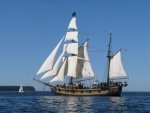Well, this is an interesting thread on fuel flow meters. And best practice on fuel useage.
First, 1/3, 1/3, 1/3 for gas tank usage is standard. A calibrated fuel gauge will tell you when you are at each point, if you have a fuel gauge. Or a fuel flow meter that has a totalizer. I would think any fuel flow meter made today would have one. However, I don't need a flow gauge to give an accurate reading of when I'm under 1/2, I've planned my fuel stops.
As for running at the best speed, a fuel flow meter that gives MPG can be used to give the best mileage. For a 25 (monohull) that's easy. Hull speed gives the best mileage and once you're up on plane, you can set the RPM to give you the best cruising speed whether it's 15 knts or 20 knts. That will vary with the boat and load, but it's easy to find. I find that faster requires more fuel, others may not.
So now to the point of this post, it appears that there are many good fuel flow meters. The Optio, discussed here is one that has a wireless output, requiring a smartphone or equivalent. If you don't want to tie up your smartphone, there are others, cheaper, with a NMEA 2000 output that would be displayed on your MFD. I think a quick Internet search of boat fuel flow meters would provide many options.
I have a dedicated fuel flow meter that displays total fuel used, MPG, lbs. per hr, etc. and I monitor it ad nauseam.
Boris

